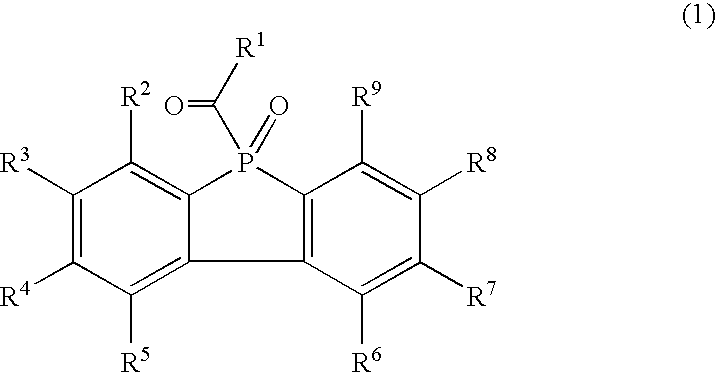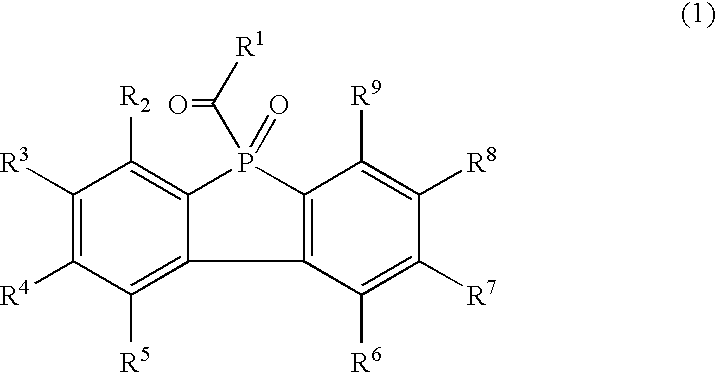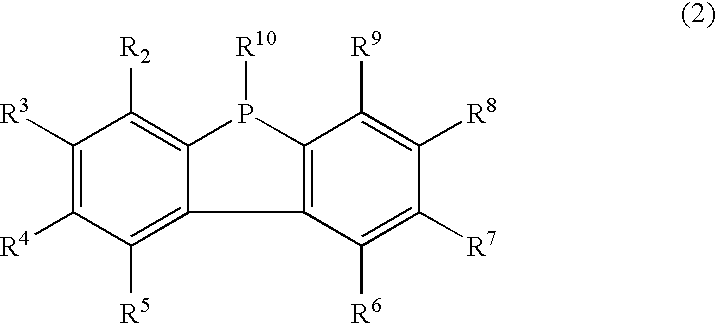Resin composition
a technology of composition and resin, applied in the field of resin composition, can solve the problems of difficult to completely mask minute parts, damage and deterioration of adjacent materials, and production of inferior products
- Summary
- Abstract
- Description
- Claims
- Application Information
AI Technical Summary
Benefits of technology
Problems solved by technology
Method used
Image
Examples
synthesis example 1
Synthesis of 9-Phenyl-9-Phosphafluorene (Compound 2)
[0097]Tetrahydrofuran (200 mL) and diethylamine (90 mL) were put into a flask equipped with a reflux condenser, and the mixture was cooled to 0° C. in an atmosphere of nitrogen, followed by dropwise addition of an n-butyl lithium / n-hexane solution (1.6 mol / L, 500 mL; Kanto chemical co., Inc.) over 4 hours. Then, tetraphenylphosphonium bromide (163 g; Hokko chemical Industry co., Ltd.) was gradually added and the resulting mixture was stirred at 0° C. for one hour and at room temperature for 3 hours. After the reaction mixture was cooled to 0° C., water (100 mL) and then hydrochloric acid (2M, 500 mL) were gradually added. The reaction product was extracted with ether (500 mL), and the organic layer was washed with a saturated aqueous solution of sodium chloride (500 mL) and dried over anhydrous magnesium sulfate. After filtration, the product was concentrated using a rotary evaporator and recrystallized from toluene / methanol. The c...
synthesis example 2
Synthesis of 9-(2,4,6-Trimethylbenzoyl)-9-Oxo-9-Phosphafluorene (Compound 1-1)
[0098]9-Phenyl-9-phosphafluorene (650 mg, 2.5 mmol), tetrahydrofuran (7.5 mL) and lithium metal (45 mg, 15 mmol) were put into a flask equipped with a reflux condenser, and the mixture was stirred at room temperature for 3 hours in an atmosphere of argon. After the reaction solution was transferred into a flask equipped with a reflux condenser (atmosphere of argon, room temperature), tert-butyl chloride (0.27 mL, 2.5 mmol) was added thereto, and the resulting mixture was stirred for 10 minutes with heating at 60° C., followed by cooling to room temperature. The resulting mixture was added dropwise to a flask (atmosphere of argon) containing a tetrahydrofuran solution (7.5 mL) of 2,4,6-trimethylbenzoyl chloride (460 mg, 2.5 mmol) cooled to −78° C. The reaction mixture was stirred at −78° C. for 15 minutes, and oxygen gas (1 atm) was blown into the flask. Then the mixture was stirred for one hour and the tem...
synthesis example 3
Synthesis of 9-Oxo-9-(4-Toluoyl)-9-Phosphafluorene (Compound 1-2)
[0106]Reaction was carried out in the same manner as in Synthesis Example 2 except that p-toluoyl chloride was used in place of 2,4,6-trimethylbenzoyl chloride, and the reaction solution was concentrated. The residue was diluted with dichloromethane (5 mL) and purified by separation with silica gel column chromatography (diethyl ether:n-hexane=5:1). The eluate was concentrated and the residue was recrystallized from dichloromethane / n-hexane solvent mixture. The crystals obtained by filtration were dried under reduced pressure to obtain compound 1-2 (yield: 52%, 413 mg).
(Compound 1-2)
[0107]1H NMR (CDCL3, PPm): δ2.49 (s, 3H), 7.34-7.37 (m, 2H), 7.36 (D, J=7.74 Hz, 2H), 7.48 (Dt, J=0.98, 7.47 Hz, 2H), 7.74 (DD, J=4.85, 7.47 Hz, 2H), 7.92 (D, J=7.74 Hz, 2H), 8.01 (DD, J=2.11, 8.18 Hz, 2H)
[0108]13C NMR (CDCL3, PPm): δ23.82, 121.78, 128.07 (D, J=7.77 Hz), 128.96 (D, J=8.98 Hz), 129.31, 129.82, 130.46 (D, J=28.56 Hz), 131.58 ...
PUM
| Property | Measurement | Unit |
|---|---|---|
| temperature | aaaaa | aaaaa |
| temperature | aaaaa | aaaaa |
| weight ratio | aaaaa | aaaaa |
Abstract
Description
Claims
Application Information
 Login to View More
Login to View More - R&D
- Intellectual Property
- Life Sciences
- Materials
- Tech Scout
- Unparalleled Data Quality
- Higher Quality Content
- 60% Fewer Hallucinations
Browse by: Latest US Patents, China's latest patents, Technical Efficacy Thesaurus, Application Domain, Technology Topic, Popular Technical Reports.
© 2025 PatSnap. All rights reserved.Legal|Privacy policy|Modern Slavery Act Transparency Statement|Sitemap|About US| Contact US: help@patsnap.com



